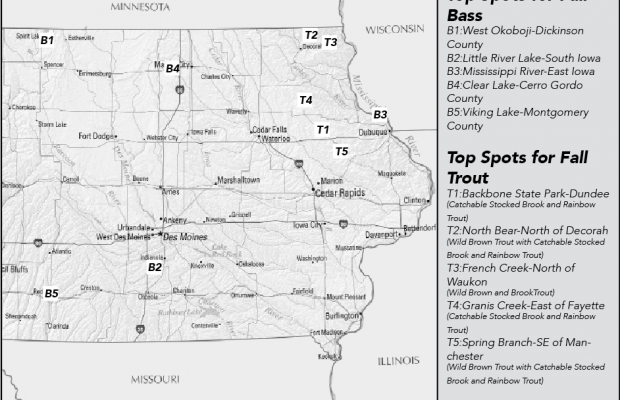Autumn brings bass to shoreline cover

By: AJ Godbey
Winter is slowly approaching, and the normal spring to fall bass fishing season will be about over for the year. However, there will be a small window of opportunity to hit the water a few more times for largemouth bass before it gets too cold. The good news is hooking into those bass will be a lot more simple during the cool months.
After mid September when the water temperature cools below 70 degrees, the fish will start moving to shallow water where it’s a bit warmer. For a lot of anglers, it’s game on because they will be easier to locate. The farthest you should really have to cast out is no more than about 10 feet, and in a lot of cases the fish will be hanging out even more shallow than that.
Now you could fish in the open water all day long and be satisfied; however, those big bass are where the fun is at. Cover is the key. Cover is anything like tall grass, weeds, tree branches or any type of structure in the water where those fish like to hide out. This is where you can land those “wall mounting” bass.
 When you show up to a lake, pond or wherever you’re fishing, take a look at the landscape surrounding the water. Look for different characteristics in the shoreline: things like peaks, vegetation, little grooves or pockets of water, anything out of the ordinary because most likely you’ll be able to locate fish in these areas. If you decided to fish the vegetated areas with tall grass, lily pads, etc., don’t be afraid to throw into those places. Even though it may be messy and crowded, this is where you’re going to find big bass.
When you show up to a lake, pond or wherever you’re fishing, take a look at the landscape surrounding the water. Look for different characteristics in the shoreline: things like peaks, vegetation, little grooves or pockets of water, anything out of the ordinary because most likely you’ll be able to locate fish in these areas. If you decided to fish the vegetated areas with tall grass, lily pads, etc., don’t be afraid to throw into those places. Even though it may be messy and crowded, this is where you’re going to find big bass.
I would recommend weedless lures or anything with a hook guard that you can drag through congested areas. Remember, even though your lure may not be submerged in the water due to lots of grass and brush, the fish will still jump out of the water to grab that bait if they want it. You have to entice the bite. Make those fish want that bait, and what I mean by that is give your rod a twitch or a jiggle to make your bait move like something they’ve never seen before. This is an important factor to trigger a hit and could potentially result in a prized fish.
The second key to finding big bass is to find the bait fish. Wherever the bait fish are, that’s where the bass will be feeding on shad and other things.
Start by using search baits. Search baits are baits that cover a lot of water fast, and most likely you’ll get bit while looking for fish. Different search baits you can use are things like spinnerbaits, crankbaits and buzzbaits. Once you get a hit, slow down and fish the area for a while because if there’s one fish there, usually there will be a school nearby. If you’re bank fishing, use a fan casting pattern back and forth until you get bit. If you don’t get a bite within the first 10 minutes, move to a different spot so you’re not wasting time where fish aren’t present.
Crankbaits are really good to use in the fall. They imitate those shad and minnows. There are tons of different crankbaits you can use with many different sizes and many different lip characteristics for different actions. Pick out some colors that you like and keep fishing them over and over again. Change the speed, the depth, the water column and the cadence until the bass lock on. A lot of times the bass target the weak or injured fish because they’re easier to feed on, so you can also try to imitate those fish as well.
Remember, baits and colors are all personal preference. Something that works well for you may not work as well for other people. It’s about what you’re comfortable with and what works well for you. Also remember, patience is the key to fishing, so no matter what, enjoy your time on the water. The more time you spend doing something, the better you get.
Good luck and good fishing!









You must be logged in to post a comment Login